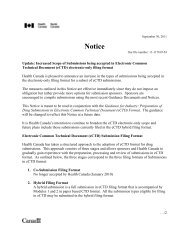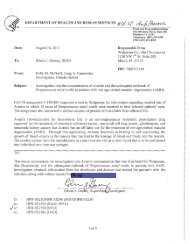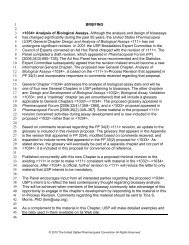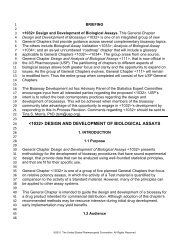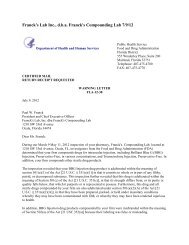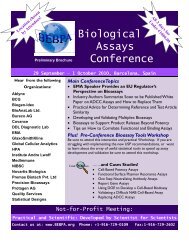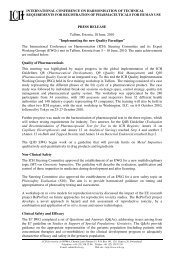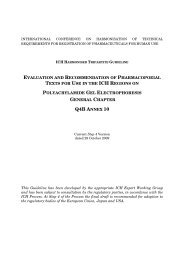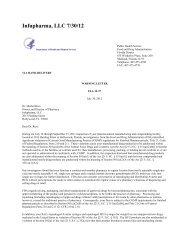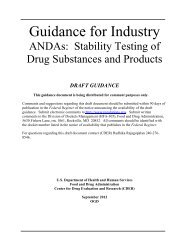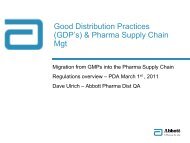concept paper on the Q3D initiative - IPQ
concept paper on the Q3D initiative - IPQ
concept paper on the Q3D initiative - IPQ
Create successful ePaper yourself
Turn your PDF publications into a flip-book with our unique Google optimized e-Paper software.
FINAL <strong>Q3D</strong> C<strong>on</strong>cept Paper Endorsed: 29 Octobre 2009<br />
appropriate c<strong>on</strong>trols for those metals with clearly established toxicological c<strong>on</strong>cerns.<br />
These metal impurities may arise from <strong>the</strong> drug substances, excipients, or manufacturing<br />
processes used for drug products, and may include catalysts, reagents, ligands, heavy<br />
metals or o<strong>the</strong>r residual metals, such as those due to <strong>the</strong> material source (e.g. Pb, Hg, As,<br />
Cd). With a focus <strong>on</strong> safety of <strong>the</strong> finished dosage form provided to <strong>the</strong> patient, a new<br />
ICH guideline would assure appropriate c<strong>on</strong>trol for <strong>the</strong> specific metals that are likely to<br />
be present in particular drug products and ingredients.<br />
Background to <strong>the</strong> Proposal<br />
Current c<strong>on</strong>trol of metal impurities is primarily based <strong>on</strong> pharmacopoeial requirements<br />
for Heavy Metals, which have been widely used for routine screening of pharmaceutical<br />
ingredients since <strong>the</strong> early 20 th century. The comm<strong>on</strong>ly used methodology was mainly<br />
intended to c<strong>on</strong>trol metals which form a sulphide precipitate, such as lead, copper and<br />
o<strong>the</strong>r metals which were potential c<strong>on</strong>taminants from water pipes, manufacturing<br />
equipment, processes, and o<strong>the</strong>r comm<strong>on</strong> sources. Although <strong>the</strong> risk factors for metal<br />
c<strong>on</strong>taminati<strong>on</strong> have changed dramatically, <strong>the</strong> standards for <strong>the</strong>ir c<strong>on</strong>trol have changed<br />
little for more than 50 years, and most Heavy Metals limits have little basis in<br />
toxicology.<br />
At <strong>the</strong> ICH Meeting in Brussels in November 2008, <strong>the</strong>re was some preliminary<br />
discussi<strong>on</strong> of <strong>the</strong> potential need and benefit of a harm<strong>on</strong>ised guideline for metal<br />
impurities. Previously, <strong>the</strong> Expert Working Group <strong>on</strong> Quality developed <strong>the</strong> Q3A, Q3B,<br />
and Q3C guidelines in order to provide a harm<strong>on</strong>ised approach to limiting impurities.<br />
Toxicologists also provided input <strong>on</strong> <strong>the</strong> subject of impurities, particularly with regard to<br />
toxicity of process-related impurities and residual solvents. The existing ICH guidelines<br />
have generally been incorporated into <strong>the</strong> pharmacopoeial standards dealing with<br />
impurities. Extending this approach to provide a similar harm<strong>on</strong>ised outcome for<br />
addressing metal impurities would avoid different limits being c<strong>on</strong>sidered am<strong>on</strong>g <strong>the</strong><br />
regulatory agencies and <strong>the</strong> pharmacopoeias.<br />
Type of Expert Working Group<br />
It is recommended to form an EWG composed of chemists (with backgrounds in QA and<br />
R&D) al<strong>on</strong>g with toxicologists to develop <strong>the</strong> appropriate guideline for c<strong>on</strong>trol of metal<br />
impurities. The ability to start with <strong>the</strong> EMEA guideline <strong>on</strong> metal impurities, which was<br />
structured in a manner similar to <strong>the</strong> ICH Q3C guideline for residual solvents, should<br />
make it feasible to develop <strong>the</strong> proposed guideline within <strong>on</strong>e to two years of initiati<strong>on</strong><br />
of <strong>the</strong> work.<br />
-2-



